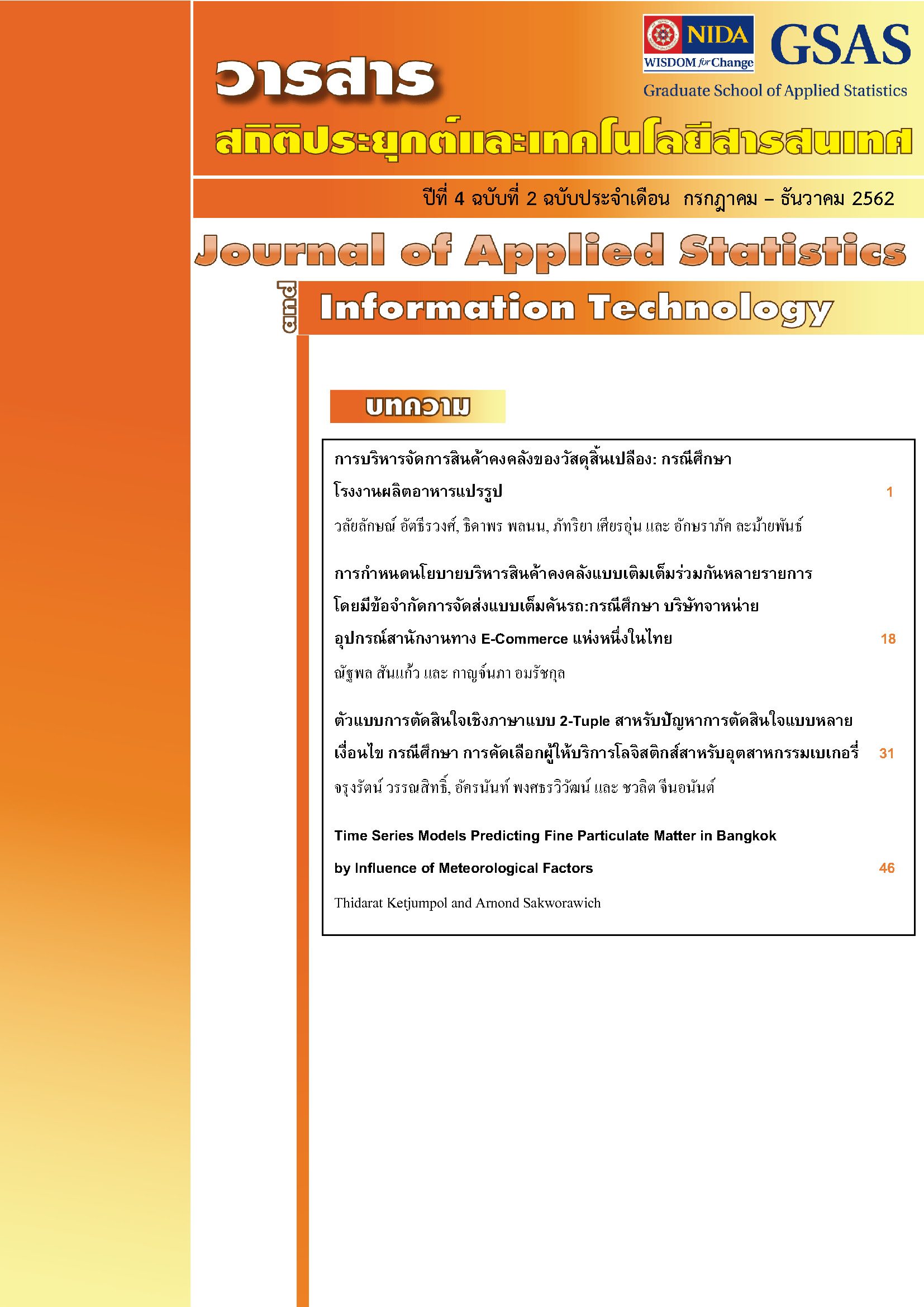A 2-Tuple Linguistic Decision Model for Multi-Criteria Decision-Making Problem Case Study of Selecting Logistic Service Provider in the Bakery Industry
Keywords:
Logistic provider selection problem, Multiple-Criteria decision making problem, Bakery industry, Linguistic information, 2-Tuple modelAbstract
A logistic provider selection problem is one of the most important business issues in a bakery industry. The best supplier can generate the superior performances for a company. However, there is a lack of research investigating on this issue. The objective of this research is to develop a decision-making model for logistic provider selection problems in a bakery industry. This research formulates a decision-making situation as multiple-criteria decision making problem under linguistic variables. In order to do so, the research was corrected data from a case study company where produces a bakery for exporting to Japan and several countries. The sample set is three selected logistic provider companies where is working in logistics sector more than 15 years. These three companies as alternatives were evaluated from three expert, who is working in the company more than 10 years, with regard to each criterion. By applying a 2-Tuple linguistic representation and computation model, the results of this research show that the ranking of the case companies is that the case company “3” is the most preferable company regarding the evaluations from three evaluators. And the final ranking is that company 3 > company 1 > company 2. Apart from the benefits of helping a decision-makers to easily making their decision, the 2-tuple model can overcome the loss of information which affects the consistency of the final ranking. This research provides new knowledge of how to make a decision under linguistic information environment in a bakery industry not only criteria for evaluation, but also a computational model for applying this proposed model to solving practical business issues.
References
Veridian E-Journal, Silpakorn University (Humanities, Social Sciences and arts), 6(2), 1037-1046.
สถาพร โอภาสานนท์. (2556). การตัดสินใจแบบพิจารณาหลายเกณฑ์. วารสารบริหารธุรกิจ, 36(140), 5-9
ศุภลักษณ์ ใจสูง. (2555). การคัดเลือกผู้ให้บริการโลจิสติกส์ของบริษัท ฮานา ไมโครอิเล็กโทรนิคส จำกัด (มหาชน) โดย
ใช้กระบวนการตัดสินใจแบบวิเคราะห์ลำดับชั้น (AHP). วารสารบริหารธุรกิจ, 35(134), 65-89
Benyoucef, D.H. and Xiaolan, X. (2003). Supplier Selection Problem: Selection Criteria and Methods. New
York, NY: McGraw-Hill.
Herrera, F. and Martinez, L. (2000). A 2-tuple fuzzy linguistic representation model for computing with
words. IEEE Transactions on fuzzy systems, 8(6), 746-752.
Herrera, F. and Martinez, L. (2000). An approach for combining linguistic and numerical Information based on
the 2-tuple fuzzy linguistic representation model in decision-making. International Journal of Uncertainty, Fuzziness and Knowledge-Based Systems, 8(05), 539-562.
Herrera, F. and Martinez, L. (2001). The 2-tuple linguistic computational model: advantages of its linguistic
description, accuracy and consistency. International Journal of Uncertainty, Fuzziness and Knowledge-Based Systems, 9(supp01), 33-48.
Huynh, V. N., & Nakamori, Y. (2005). A satisfactory-oriented approach to multiexpert decision-making with
linguistic assessments. IEEE Transactions on Systems, Man, and Cybernetics, Part B (Cybernetics), 35(2), 184-196.
Huynh, V. N., Yan, H. and Nakamori, Y. (2010). A target-based decision-making approach to consumer-
Oriented evaluation model for Japanese traditional crafts. IEEE Transactions on
Engineering Management, 57(4), 575-588.
Martinez, L. and Herrera, F. (2012). An overview on the 2-tuple linguistic model for computing with words in
decision making: Extensions, applications and challenges. Information Sciences, 207, 1-18.
Saaty, T. L. (2008). Decision making with the analytic hierarchy process. International journal of
services sciences, 1(1), 83-98.
Vargas, L.G. (1990). An overview of the analytic hierarchy process and its application, European Journal of
Operational Research, Vol. 48, no. 1.
Wang, J. H. and Hao, J. (2006). A new version of 2-tuple fuzzy linguistic representation model for computing \ with words. IEEE transactions on fuzzy systems, 14(3), 435-445.
Yu, P. L. (2013). Multiple-criteria decision making: concepts, techniques, and extensions (Vol. 30). Springer
Science & Business Media.
Zadeh, L. A. (1996). Fuzzy sets. In Fuzzy Sets, Fuzzy Logic, And Fuzzy Systems: Selected ‘Papers by Lotfi A
Zadeh (pp. 394-432).
Downloads
Published
How to Cite
Issue
Section
License
เนื้อหาและข้อมูลที่ปรากฏในบทความที่ตีพิมพ์ในวารสารสถิติประยุกต์และเทคโนโลยีสารสนเทศถือเป็นความคิดเห็นส่วนบุคคลของผู้เขียนแต่ละท่าน ความผิดพลาดของข้อความและผลที่อาจเกิดจากนำข้อความเหล่านั้นไปใช้ผู้เขียนบทความจะเป็นผู้รับผิดชอบแต่เพียงผู้เดียว บทความ ข้อมูล เนื้อหา รูปภาพ ฯลฯ ที่ได้รับการตีพิมพ์ในวารสารถือเป็นลิขสิทธิ์ของวารสาร หากบุคคลหรือหน่วยงานใดต้องการนำทั้งหมดหรือส่วนหนึ่งส่วนใดไปเผยแพร่ต่อหรือเพื่อกระทำการใดๆ จะต้องได้รับอนุญาตเป็นลายลักอักษรณ์จากวารสาร ก่อนเท่านั้น



